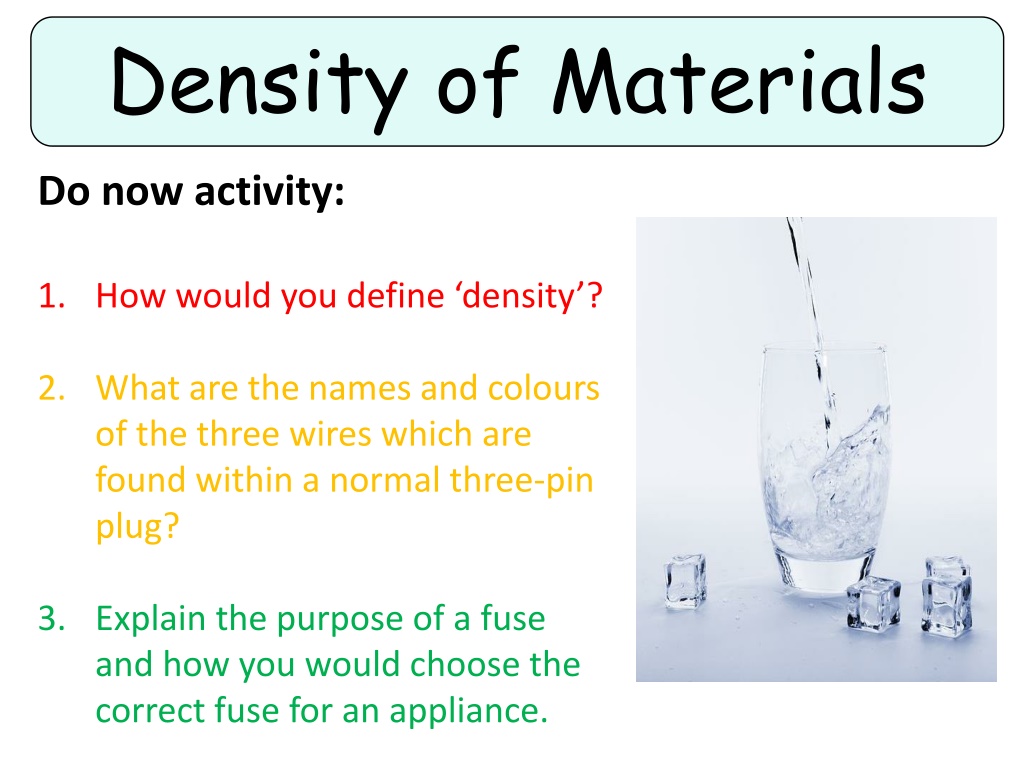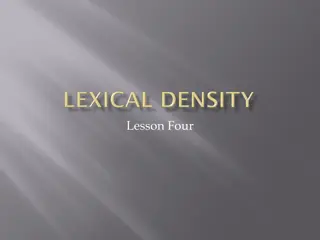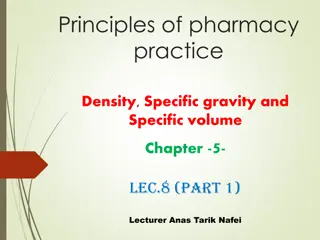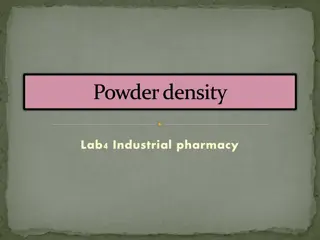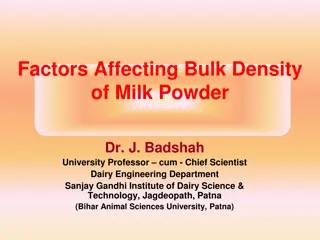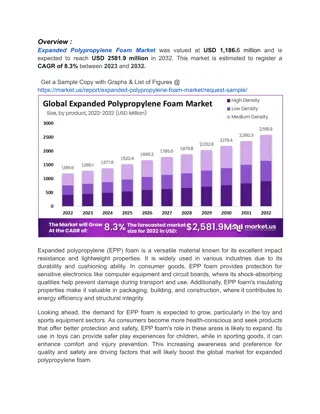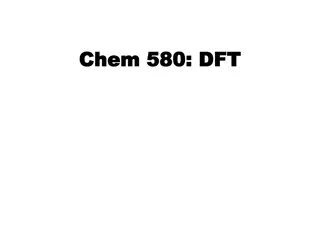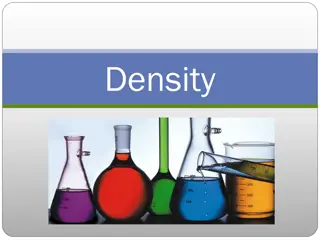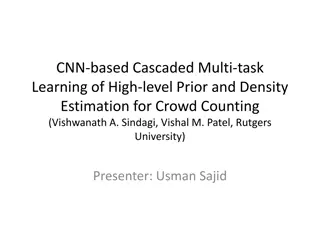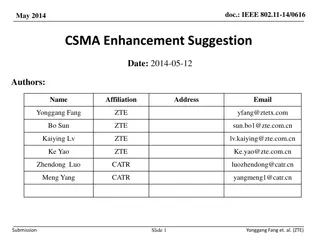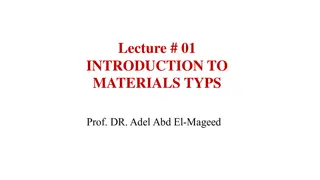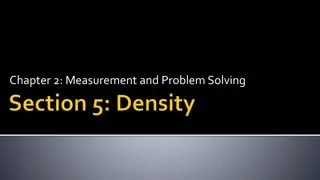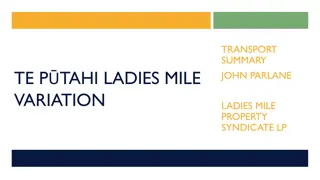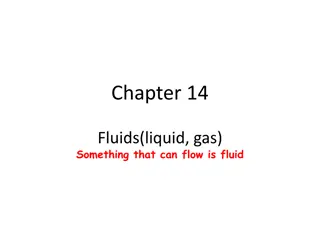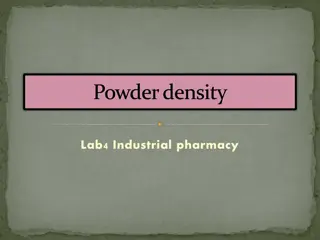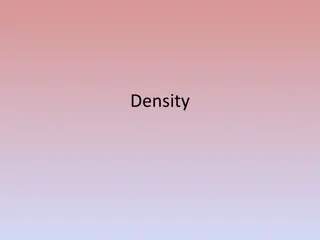Understanding Density of Materials Activity
Density is defined as the mass per unit volume of a material. In this activity, students learn to measure and calculate the density of solid objects or liquids using the density equation. They also explore the concept of density through practical examples and self-assessment tasks. Additionally, the activity covers topics such as the three wires in a three-pin plug, the purpose of fuses, and choosing the correct fuse for appliances. Converting units and using standard form for mass and volume measurements are also discussed.
Download Presentation

Please find below an Image/Link to download the presentation.
The content on the website is provided AS IS for your information and personal use only. It may not be sold, licensed, or shared on other websites without obtaining consent from the author. Download presentation by click this link. If you encounter any issues during the download, it is possible that the publisher has removed the file from their server.
E N D
Presentation Transcript
Density of Materials Do now activity: 1. How would you define density ? 2. What are the names and colours of the three wires which are found within a normal three-pin plug? 3. Explain the purpose of a fuse and how you would choose the correct fuse for an appliance.
Grade Objective To be able to recall the density equation and use this to determine the density of a material Outcomes To be able to define density 1-3 To be able to measure the density of a solid object or a liquid To be able to use the density equation to calculate the mass or the volume of an object or a sample. 4-6 7-9
Density is the mass per unit volume. Which box is more dense? The box that has more balls has more mass per unit of volume and would weigh the most. This property of matter is called density.
Units p = kg/m3 Q: If the mass of a block of aluminium has a mass of 50,000kg and a volume of 18m3 what is the density of aluminium? m = kg V = m3
How would you rearrange this formula to work out the: Mass of the object = densityx volume P x V Volume of the object = Mass x density m x d
Task: Copy and complete the table to identify the density/volume/mass of a solid material: Volume (m3) Material Mass (kg) Density (kg/m3) Gold 6 123,000 Zinc 2.8 7135 Silver 330,000 10490 Copper 29 26,000 Iron 157,480 7,874 Wood 1000 510 Extension: Write a list of materials starting from the most dense to the least dense
Self-assessment: Volume (m3) Material Mass (kg) Density (kg/m3) Gold 6 123,000 20,500 Zinc 2.8 19,978 7135 Silver 31.5 330,000 10490 Copper 29 26,000 896.6 Iron 20 157,480 7,874 Wood 1000 510 0.51
Converting units and using standard form: Maths skills 1kg = 1000g =103 g 1m = 1,000,000cm3 = 106 cm3 Standard form is written as A x 10n In standard form n is the number of places you have had to move the decimal point to the left (or right for a negative power of 10) to get the decimal number A.
Converting numbers into standard form: Example: 150,000cm3 = 1.5 x 105 cm3 1. 2.6 x 103 cm3 2. 5.6 x 105 cm3 3. 2.0 x 103 cm3 4. 1.0 x 10-1 cm3 5. 6.0 x 102 cm3 6. 2.5 x 108 cm3 1. 2,600cm3 2. 560,000cm3 3. 2000cm3 4. 0.1cm3 5. 600cm3 6. 250,000,000cm3
Exam-style question The helium in the balloon has a mass of 0.00245 kg. The balloon has a volume of 0.0141m3. Calculate the density of helium. Choose the correct unit from the box. m3/kg kg/m3 kg m3 (3 marks) Mark Scheme: Density = Mass / Volume Density = 0.00254 kg / 0.0141 m3 Density = 0.18 Units: kg/m3
Problem-solving: 1. Matt had a block of copper of mass 5000kg, the dimensions of the block were as follows: Width 1m, Height 2m, Length 3m. What is the density of the block? 2. Syra knew the density of an iron block, it was 7900kg/m3. The mass of the bar was 7900kg, what were the dimensions of the iron block? Make sure you show all your working!!
Self-assessment: 1. Volume = Width x Length x Height Volume = 1m x 2m x 3m, Volume = 6m3 Density = Mass / Volume Density = 5000kg / 6m3 ,Density = 833.3 kg/m3 2. Volume = Mass / Density Volume = 7900 kg / 7900 kg/m3 Volume = 1 m3 So, the dimensions must be = Width = 1m, Length = 1m, Height = 1m
Measuring the density of a liquid 1. Firstly, pour the liquid into a measuring cylinder to work out the volume. 2. Next, find the mass of an empty beaker by placing it on a top-pan balance. 3. Remove the beaker from the balance, pour the liquid from the measuring cylinder into the beaker. 4. Use the balance to find out the mass of the beaker and the liquid. 5. Find the mass of the liquid by subtracting the mass of the empty beaker from the mass of the beaker + the liquid. 6. Density = Mass / Volume
Quick Check A measuring cylinder contained a volume of 150cm3 of a liquid. The liquid was then poured into an empty beaker of mass 65g. The total mass of the beaker and the liquid was the found to be 235g. a) Calculate the mass of the liquid in grams b) Calculate the density if the liquid in kg / m3 (2 marks) (2 marks) Self-assessment: a) Calculate the mass of the liquid in grams: 235g 65g = 170g b) Calculate the density if the liquid in kg / m3 : Density = Mass / Volume Density = 170g / 150cm3 = 1.13 g/cm3
True or False? To calculate density you divide the volume by the mass To calculate the volume of an object you can divide the mass by the density Density is measured in kg/m3 160,000cm3 in standard form is 1.6 x 107 cm3 0.0005m3 in standard form is 5 x 10-5 m3 The volume of an object which has a height of 2cm3, a width of 6cm3 and a length of 3cm3 has a volume of 36cm3 TRUE FALSE TRUE TRUE FALSE FALSE
Plenary ~ Write three sentences to summarise what you have learnt this lesson!
